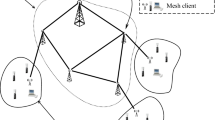Abstract
Routing in Wireless Mesh Networks is challenging due to the unreliable characteristics of the wireless medium. Traditional routing paradigms are not able to propose an efficient solution to this problem. Further, Gupta et al. demonstrated that the average throughput capacity per node of a wireless multi-hop network decreases as 1/n, where n is the number of nodes in the network. Recent studies have shown that a cross-layer approach is a promising solution to get closer to the theoretic throughput capacity bound. Cross-layer solutions have been already proposed either for specific TDMA/CDMA networks or for power-efficient routing protocols. These proposals are strongly MAC dependent, or suffer from targeting a steady state offering the best trade-off performance. In this paper, the problem we tackle in a more general context, disregarding the specific MAC and Physical layers technologies, can be formulated as follows: How to design a routing algorithm able to increase the average throughput capacity experienced by Wireless Mesh Networks?
Starting from a theoretic result, we analyze the gain that a cross-layer approach can deliver, the metrics suitable to improve throughput capacity, and the power control policy that reduces interference. We take a MAC independent approach, focusing on the general characteristics of wireless links, targeting the improvement of throughput capacity in Wireless Mesh Networks. Our proposal performs path selection and power optimization based on three metrics, namely physical transmission rate, interference, and packet error rate. Performances are thoroughly analyzed and evaluated by extensive simulations, with both TCP and UDP traffic, and compared to other multi-hop routing protocols. For both kind of traffic, the simple heuristic we propose here allows to double the average throughput the network is able to route.
Similar content being viewed by others
Abbreviations
- WMN:
-
Wireless Mesh Network
- WMR:
-
Wireless Mesh Router
References
D. Beyer, Fundamental characteristics and benefits of wireless routing (mesh) networks, Wireless Communications Association International Technical Symposium, Jan. 2002.
I. Akyildiz, X. Wang and W. Wang, Wireless mesh networks: a survey, Computer Networks – Elsevier Science, no. 47, Jan. 2005.
D.D. Couto, D. Aguayo, B. Chambers and R. Morris, Performance of multi-hop wireless networks: Shortest path is not enough, Proceedings of First Workshop on Hot Topics in Networks (HotNets-I), Oct. 2002.
H. Lundgren, E. Nordström and C. Tschudin, Coping with communication gray zones in ieee 802.11b based ad hoc networks, Proceedings of 5th ACM International Workshop on Wireless Mobile Multimedia (WoWMoM'02), Sept. 2002.
P. Gupta and P. Kumar, The capacity of wireless networks, IEEE Transactions on Information Theory, Mar. 2000.
J. Gomez and A. Campbell, A case for variable-range transmission power control in wireless ad hoc networks, Proceedings of IEEE INFOCOM'04, Mar. 2004.
A. Goldsmith, Wireless Communications. Avalable online at http://wsl.stanford.edu/andrea/wireless/: Cambridge University Press.
L. Iannone and S. Fdida, On the transmission effectiveness in multi-rate power-control capable wireless networks, Proceedings of EUNICE 2003, Sept. 2003.
R. Khalili and K. Salamatian, Evaluation of packet error rate in wireless networks, Proceeding of MSWIM'04, 2004.
Z. Wang and J. Crowcroft, Bandwidth-delay based routing algorithms, Proceedings of IEEE GLOBECOM'95, Nov. 1995.
M. Garey and D. Johnson, Computer and Intractability – A Guide to the Theory of NP-Completeness. California: Freeman, 1979.
J. Garcia-Luna-Aceves, A unified approach to loop-free routing using distance vectors of link states, Proceedings of ACM SIGCOMM'89, Sept. 1989.
J. Jaffe, Algorithms for finding paths with multiple constraints, Networks, no. 14 (1984) 95–116.
The network simulator ns-2. [Online]. Available: http://www.isi.edu/nsnam/ns/
R. Punnoose, P. Nikitin and D. Stancil, Efficient simulation of ricean fading within a packet simulator, Proceedings of IEEE VTC2000-spring, Sept. 2000.
IEEE, Wireless lan medium access control (mac) and physical layer (phy) specifications, IEEE Standard 802. 11, June 1999.
E. Perkins, E. Belding-Royer and S. Das, Ad hoc on demand distance vector (aodv) routing, RFC 3561.
C. Perkins and P. Bhagwat, Higly dynamic desination-sequenced distance-vector (dsdv) routing for mobile computers, Proceedings of ACM SIGCOMM'94, Sept. 1994.
D. B. Johnson and D. A. Maltz, Dynamic source routing in ad hoc wireless networks, Mobile Computing, 353(1996).
Author information
Authors and Affiliations
Corresponding author
Rights and permissions
About this article
Cite this article
Iannone, L., Fdida, S. Evaluating a cross-layer approach for routing in Wireless Mesh Networks. Telecommun Syst 31, 173–193 (2006). https://doi.org/10.1007/s11235-006-6519-5
Received:
Accepted:
Issue Date:
DOI: https://doi.org/10.1007/s11235-006-6519-5




